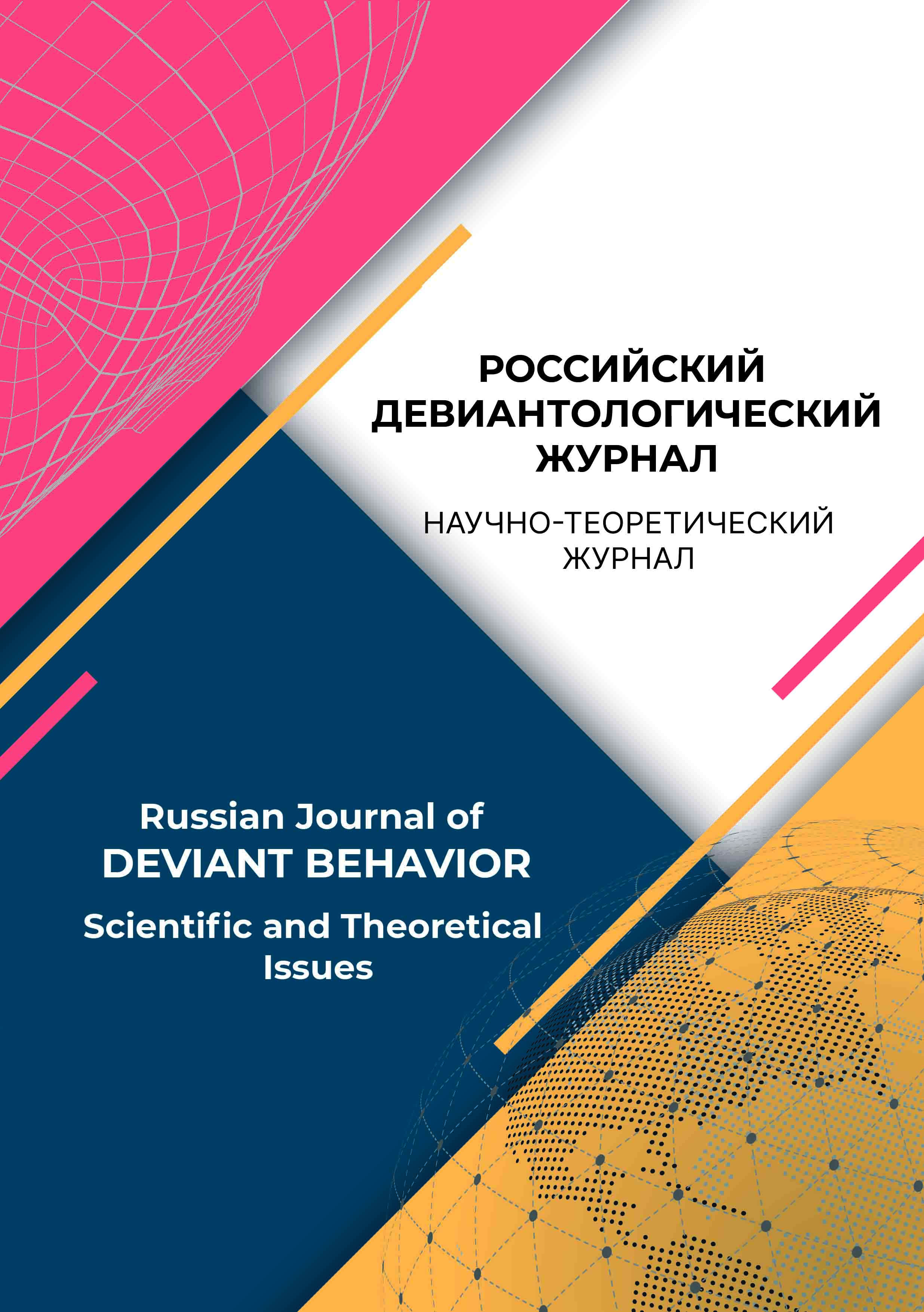St. Petersburg, St. Petersburg, Russian Federation
from 01.01.2024 until now
Astrakhan Suvorov Military School of the MIA of Russia (course management, head of the course)
from 01.01.2012 to 01.01.2023
Saint Petersburg, St. Petersburg, Russian Federation
UDC 37.026
Introduction. Prevention of deviant behaviour of older adolescents is one of the urgent modern socio-pedagogical tasks, which in the Suvorov military schools of the Ministry of Internal Affairs of Russia should be solved by the employees of the course units. The problem lies in their lack of competence, as well as in the absence of standards for the organisation of relevant training. Analysis of the psychological and pedagogical field of deviant behaviour among older adolescents in domestic and foreign literature makes it possible to define deviation as a deviation from the norm recognised in specific social conditions, while prevention can be considered as an activity that counteracts the negative factors of its occurrence. The aim of this research is to substantiate an effective way of training course employees of Suvorov military schools of the Ministry of Internal Affairs of Russia for working on the prevention of deviant behaviour among older adolescents. Research methods. The methodological basis of the research was based on the humanitarian-anthropological and andragogical approaches and the theory of internal training. The research was implemented on the basis of one of the Suvorov Military Schools of the Russian Ministry of Internal Affairs using theoretical and empirical methods: analysis, generalisation, systematisation of the obtained data, pedagogical projecting, experiment, survey and content analysis of reflexive texts. Results. The authors analysed the theory and practice of pedagogical competence formation under conditions of limited time resource and difficulty of training employees outside the school and chose internal training as the main type of training. The model of such training of course staff was created on the basis of implicative connection of nine procedural-methodological blocks, the relevant programme was developed. The programme was tested from 2019 to 2024 and its effectiveness was proved in the experimental work. The hypothesis of the present research was confirmed, the goal was achieved through the successive solution of tasks. Further research of internal training as an effective way of training employees of educational organisations of the Ministry of Internal Affairs of Russia seems perspective.
adult education, professional training, course employees, Suvorov military schools of the Ministry of Internal Affairs of Russia, deviant behaviour, older adolescents
1. Ananchenkova, P. I. (2023). Sovremennye modeli vnutrifirmennogo obucheniya. Vestnik Moskovskogo gumanitarno-ekonomicheskogo instituta, 1, 265–276.
2. Antilogova, L. N. (2023). Harakter mezhlichnostnyh otnoshenij i uroven' konfliktnosti deviantnyh podrostkov. Vestnik Omskogo universiteta. Seriya: Psihologiya, 4, 39–48.
3. Ilakavichus, M. R. (2021). Antropopraktiki v obrazovatel'nom processe organizacij vysshego obrazovaniya sistemy MVD Rossii. Prepodavatel' XXI vek, 4 (1), 79–87. https://doi.org/10.31862/2073-9613-2021-4-79-87
4. Selin, P. V., Ilakavichus, M. R. (2024). Podgotovka nachal'stvuyushchego sostava i pedagogicheskih rabotnikov suvorovskih voennyh uchilishch MVD Rossii k sovmestnoj vospitatel'noj deyatel'nosti: monografiya. Saint Petersburg: Izdatel'stvo Sankt-Peterburgskogo universiteta MVD Rossii.
5. Senge, P. M. (2018). Pyataya disciplina. Iskusstvo i praktika obuchayushchejsya organizacii (per. s angl. Yu. Konstantinovoj). Moskow: Mann, Ivanov i Ferber.
6. Sychugova, L. P., Belozerova, A. V. (2021). Tekhnologiya pedagogicheskih masterskih v usloviyah onlajn-obucheniya: lingvosinergeticheskij podhod. Vestnik Vyatskogo gosudarstvennogo universiteta, 3 (141), 69–78. https://doi.org/10.25730/VSU.7606.21.035
7. Troshihina, E. G., Navdushevich, G. V. (2023). Lichnostnye prediktory assertivnosti v podrostkovom i rannem yunosheskom vozraste. Vestnik Kostromskogo gosudarstvennogo universiteta. Seriya: Pedagogika. Psihologiya. Sociokinetika, 29 (3), 62–68. https://doi.org/10.34216/2073-1426- 2023-29-3-62-68
8. Shustova, I. Yu. (2021). Obshchenie so sverstnikami: reshenie problemy negativnogo statusa shkol'nika. Vestnik Pravoslavnogo Svyato-Tihonovskogo gumanitarnogo universiteta. Seriya 4: Pedagogika. Psihologiya, 63, 114–130. https://doi.org/10.15382/sturIV202163.114-130
9. Albakova, Z. A-M., Matanis, V. A., Zakasovskaia, I. N., Malaschenko, V. O., Ilkevich, B. V., Zharikov, Y. S., & Dzhamalkhanova, L. A. (2020). Psychological and pedagogical prevention of deviant behavior among the student youth (theory and practice of domestic studies). EurAsian Journal of BioSciences, 14 (2), 4085–4093.
10. Benzaghta, M. A., Elwalda, A., Mousa, M. M., Erkan, I., & Rahman, M. (2021). SWOT analysis applications: An integrative literature review. Journal of Global Business Insights, 6 (1), 55–73. https://www.doi.org/10.5038/2640-6489.6.1.1148
11. Cioban, S., Lazăr, A. R., Bacter, C., & Hatos, A. (2021). Adolescent Deviance and Cyber-Deviance. A Systematic Literature Review. Front. Psychol, 12, 748006. https://doi.org/10.3389/ fpsyg.2021.748006
12. Gao, L., Liu, J., Hua, S., Yang, J., & Wang, X. (2022). Teacher–student relationship and adoles-cents’ bullying perpetration: A moderated mediation model of deviant peer affiliation and peer pressure. Journal of Social and Personal Relationships, 39 (7), 2003–2021. https://doi. org/10.1177/02654075221074393
13. Goode, E. (2022). Deviant Behavior (13th ed.). New York: Routledge. https://doi.org/10.4324/9781003285304
14. Granger, T. A., Cook, P. F., & Ramos, G. (2020). Adolescent Peer and Parent Relationships Into Emerging Adulthood. Western Journal of Nursing Research, 42 (2), 90–96. https://doi.org/10.1177/0193945919848439
15. Hall, G. S. (1904). Adolescence: Its psychology and its relations to physiology, anthropology, sociology, sex, crime, religion and education, Vol. 1. D Appleton & Company. https://doi.org/10.1037/10616- 000
16. Hoshang, S., Hilal, T. A., & Hilal, H. A. (2021). Investigating the Acceptance of Flipped Classroom and Suggested Recommendations. Procedia Computer Science, 184, 411–418, https://doi.org/10.1016/j.procs.2021.03.052
17. Luo, M. M., & Chea, S. (2020). Wiki use for knowledge integration and learning: A three tier conceptualization. Computers & Education, 154, 103920, https://doi.org/10.1016/j.compedu.2020.103920
18. Mahoney, J., Patterson, L., & Hall, C. (2022). De Bono's six hats thinking strategy for all content areas. Kentucky Teacher Education Journal: The Journal of the Teacher Education Division of the Kentucky Council for Exceptional Children, 9 (1), 4. https://doi.org/10.61611/2995- 5904.1039
19. Mamaraimova, Z. S. (2024). Psychological and pedagogical activities for the prevention of deviant behavior of adolescents. Modern Scientific Research International Scientific Journal, 2 (5), 327–334. https://doi.org/10.5281/zenodo.11655951
20. Martínez-Otero, V., & Leticia-Gaeta, M. (2022). Educational prevention of antisocial and delinquent behavior in Brazilian adolescents. Psicothema, 34 (4), 544–552. https://doi.org/10.7334/psicothema2022.118
21. Mayring, P. (2014). Qualitative content analysis: theoretical foundation, basic procedures and software solution. Klagenfurt.
22. Nelen, M. J. M., Blonk, A., Scholte, R. H. J., & Denessen, E. (2020). School-Wide Positive Behavior Interventions and Supports: Fidelity of Tier 1 Implementation in 117 Dutch Schools. Journal of Positive Behavior Interventions, 22 (3), 156–166. https://doi.org/10.1177/1098300719879621
23. Prati, G., & Tomasetto, C. (2022). Early pubertal development and deviant behavior: A three-year longitudinal study among early adolescents. Personality and Individual Differences, 193, 111621. https://doi.org/10.1016/j.paid.2022.111621
24. Sari, R. M., Sumarmi, S., Astina, I. K., Utomo, D. H., & Ridhwan, R. (2021). Increasing students critical thinking skills and learning motivation using inquiry mind map. International Journal of Emerging Technologies in Learning, 16 (3), 4–19, https://doi.org/10.3991/ijet.v16i03.16515
25. Seddig, D. (2020). Individual Attitudes toward Deviant Behavior and Perceived Attitudes of Friends: Self-stereotyping and Social Projection in Adolescence and Emerging Adulthood. J Youth Adolescence, 49, 664–677. https://doi.org/10.1007/s10964-019-01123-x
26. Ye, J-H, Chen, M-Y., & Wu, Y-F. (2024). The Causes, Counseling, and Prevention Strategies for Maladaptive and Deviant Behaviors in Schools. Behavioral Sciences, 14 (2), 118. https://doi. org/10.3390/bs14020118
27. Zainal, V. R., & Hakim, A. (2023). In House Training Needs Analysis For Employees. Dinasti International Journal of Education Management And Social Science, 4 (6), 912–922.














